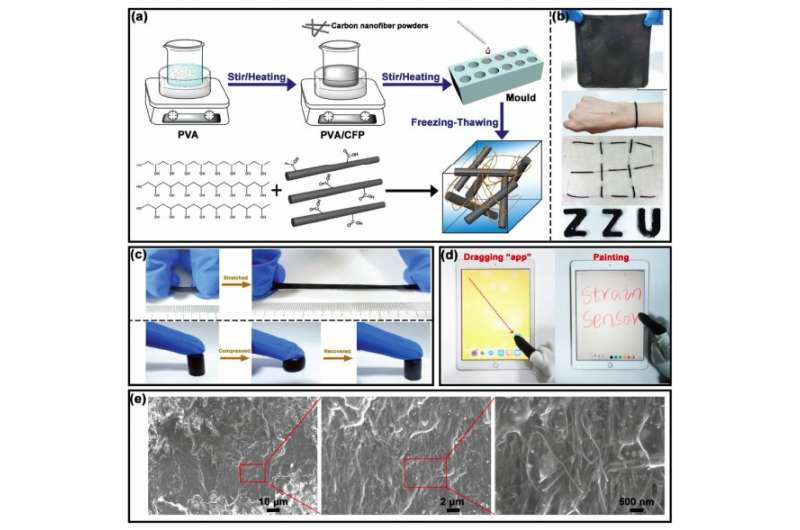March 16, 2020 feature
A stretchable, compressible sensor for wearable electronics and soft robots

Recent technological advances have enabled the development of increasingly sophisticated electronics. Some of these new tools, particularly wearable devices and soft robots, require or can greatly benefit from flexible electronic components, including sensors, actuators and supercapacitators.
Researchers at Zhengzhou University and Peking University in China have recently developed a new stretchable and compressible hydrogel strain sensor that could be used to fabricate a variety of flexible or soft technologies with sensing capabilities, including health trackers and robotic skins. This sensor, presented in a paper published in Macromolecular Materials and Engineering, is both easy to fabricate and affordable, which makes it ideal for large-scale implementations.
The researchers created it by uniformly dispersing carbon nanofiber powder (CFP) inside a polyvinyl alcohol (PVA)-based hydrogel. PVA has so far proved to be highly promising for the development of flexible electronics due to its advantageous mechanical properties and the fact that it is biodegradable.
By dispersing CFP inside the PVA-based hydrogel, the researchers were able to enhance the material's mechanical strength and increase its electrical conductivity. They employed what is known as a 'freezing-thawing cycle' method, which entails repeatedly freezing and thawing a substance.
The PVA/CFP hydrogel produced from this process was found to exhibit a wide stretching (366%) and compressing (70%) range. This makes it ideal for the development of highly flexible electronics, which can be stretched or compressed while maintaining optimal sensing capabilities.
"During 1000 loading-unloading cycles, the PVA/CFP hydrogel has a low plastic deformation (<10%, for both stretching and compressing), small energy loss efficiency (5.62% under stretching and 12.13% under compressing), and a stable mechanical strength and excellent sensitivity, whether it is stretched to 100% or compressed to 50% strains," the researchers wrote in their paper.
In addition to being fairly straightforward and effective, this method for fabricating stretchable and compressible sensors is low-cost, and could thus be easily scaled up. Moreover, it enables the development of highly performing sensors that can detect a wide range of human behaviors or activities.
For instance, sensors created using the new fabrication strategy can accurately detect when a user is bending or stretching his/her joints, breathing, and swallowing. They can also sense the changes in pressure that take place when humans are walking or moving.
The researchers tested their sensors in several scenarios, placing them on a user's wrist to detect the tensing of fist muscles, on the throat to monitor swallowing, on the stomach to detect breathing, or under the sole of shoes to monitor the user's walking behavior. They also used the same sensors to detect a human's touch and when he/she pressed on the sensor.
The carbon nanofiber-polymer hydrogel strain sensor has already achieved highly promising results, highlighting its potential for a variety of applications. In the future, it could be used to develop new wearable devices, such as smartwatches and health trackers, but it could also enable the fabrication of stretchable electronic skins with advanced sensing capabilities.
More information: Baowei Cheng et al. Highly Stretchable and Compressible Carbon Nanofiber–Polymer Hydrogel Strain Sensor for Human Motion Detection, Macromolecular Materials and Engineering (2020). DOI: 10.1002/mame.201900813
© 2020 Science X Network


















